

Asie. Central & East Asian History. China. China. Chine. China. Chine. Chine : sociétés, territoires, environnement. Maps of China - China City and Province Maps. Indice di Tutto Cina - Il portale sulla Cina. Strategia, potere, estetica, storia, filosofia della natura, da Oriente verso Occidente. Chinese philosophy. Méditation et culture chinoise. Le roman chinois contemporain. Chine. History of China. History of China. Ancient China. La Chine antique. Chine ancienne - L'armée immortelle de l'empereur Qin - Herodote.net. Tyrannique, sanguinaire, mégalomane...
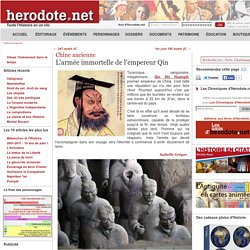
Qin Shi Huangdi, premier empereur de Chine, s'est taillé une réputation qui n'a rien pour faire rêver. Pourtant aujourd'hui c'est par millions que les touristes se rendent sur ses traces à 25 km de Xi'an, dans le centre-est du pays. C'est là en effet qu'il avait décidé de se faire construire un tombeau extraordinaire, capable de le protéger jusqu'à la fin des temps.
Vingt quatre siècles plus tard, l'homme qui ne craignait que la mort n'est toujours pas réapparu, mais l'armée qui devait l'accompagner dans son voyage vers l'éternité a commencé à sortir doucement de terre. Isabelle Grégor Un coup de pioche bien chanceux En cette année 1974, les paysans de la région de Xi'an commencent à s'inquiéter : il n'a pas assez plu, les récoltes sont en danger. La nouvelle remonte aux chefs du village, puis à la ville, puis à la capitale... et les archéologues arrivent enfin.
Des guerriers à la pelle ! En rangs serrés Son portrait pour l'éternité Et dans la tombe ? Xin Zhui: The Most Shockingly Well-Preserved Mummy In History? She died in 163 BC.
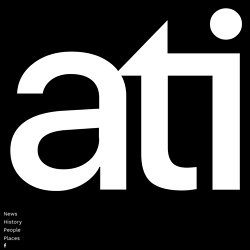
When they found her in 1971, her hair was intact, her skin was soft to the touch, and her veins still housed type-A blood. David Schroeter/FlickrThe remains of Xin Zhui. Now more than 2,000 years old, Xin Zhui, also known as Lady Dai, is a mummified woman of China’s Han dynasty (206 BC-220 AD) who still has her own hair, is soft to the touch, and has ligaments that still bend, much like a living person.
Chinese Imperial Examination System. This is an article taken from our China in Focus magazine (2002) written by Justin Crozier.
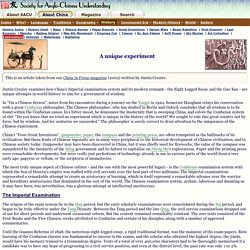
Justin Crozier examines how China's Imperial examination system and its modern remnant - the Eight Legged Essay and the Gao Kao - are unique attempts in world history to aim for a government of wisdom. In "On a Chinese Screen", notes from his encounters during a journey on the Yangzi in 1920, Somerset Maugham relays his conversation with a great Confucian philosopher. The Chinese philosopher, who has studied in Berlin and Oxford, concludes that all wisdom is to be found within the Confucian canon. In a bitter mood, he denounces the modernity that is sweeping China, and extols the Confucian system of old: “Do you know that we tried an experiment which is unique in the history of the world? Ancient Chinese Civilization. La notion de «barbares » en Chine ancienne. Gianni Sofri - La Grande Muraglia cinese. The Silk Road. On the eastern and western sides of the continent, the civilisations of China and the West developed.
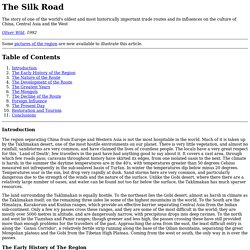
The western end of the trade route appears to have developed earlier than the eastern end, principally because of the development of the the empires in the west, and the easier terrain of Persia and Syria. The Iranian empire of Persia was in control of a large area of the Middle East, extending as far as the Indian Kingdoms to the east. Trade between these two neighbours was already starting to influence the cultures of these regions. This region was taken over by Alexander the Great of Macedon, who finally conquered the Iranian empire, and colonised the area in about 330 B.C., superimposing the culture of the Greeks.
Although he only ruled the area until 325 B.C., the effect of the Greek invasion was quite considerable. Close on the heels of the Parthians came the Yuezhi people from the Northern borders of the Taklimakan. 1434: The Year a Magnificent Chinese Fleet Sailed to Italy and Ignited the Renaissance: Gavin Menzies: 9780061492181: Books - Amazon.ca. Entretien avec François Jullien. François Jullien - Cette étrange idée du beau. Depuis quelques années déjà, dans le cadre de Citéphilo, François Jullien vient présenter à Lille son travail, prenant un plaisir manifeste à ces causeries avec le pugnace Jean-Jacques Melloul.
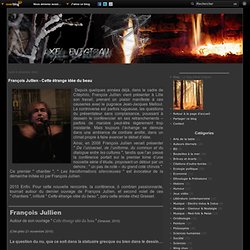
La controverse est parfois rugueuse, les questions du présentateur sans complaisance, poussant à dessein le conférencier en ses retranchements – parfois de manière peut-être légèrement trop insistante. Mais toujours l’échange se déroule dans une ambiance de cordiale amitié, dans un climat propre à faire avancer le débat d’idée. Ainsi, en 2008 François Jullien venait présenter " De l’universel, de l’uniforme, du commun et du dialogue entre les cultures ", tandis que l’an passé la conférence portait sur le premier tome d’une nouvelle série d’étude, proposant un détour par un dehors ; " un pas de coté – du grand coté chinois ".
Peinture traditionnelle chinoise. Les arts chinois figurent parmi les traditions artistiques les plus anciennes au monde.
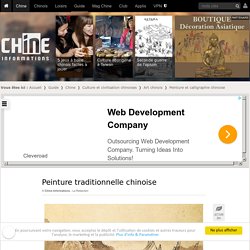
Peinture chinoise. Nous appelons peinture chinoise l’art pictural traditionnel exercé en Chine depuis plus de mille ans.
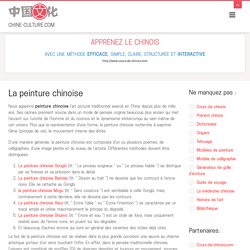
Chinese Character for Immortal: Xiān (仙) The Chinese character 仙 (xiān) refers to an immortal, a fairy, or a celestial or supernatural being.
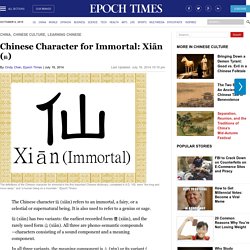
It is also used to refer to a genius or sage. 仙 (xiān) has two variants: the earliest recorded form 僊 (xiān), and the rarely used form 仚 (xiān). All three are phono-semantic compounds—characters consisting of a sound component and a meaning component. In all three variants, the meaning component is 人 (rén) or its variant 亻(rén), referring to a human being or humankind. A guide to ancient stargazing in China - BBC Sky at Night Magazine. Chinese astronomers have been studying the night sky for longer than any other culture.

The oldest star maps and the earliest records of sunspots have been unearthed by archaeologists in China, where a unique way of looking at the night sky developed about 1,200 BC. Chinese astronomers Gan De and Shi Shen are credited as the first to create star catalogues in the 4th century BC, and the Buddhist monk Yi Xing conducted an astronomical survey in the 8th century AD to help with the prediction of solar eclipses. Discover more guides like this via our History of Astronomy webpage. Happenstance. The golden light of Guanyin, the smoldering fires of a tea drying shed, callous invading armies in Fujian; they all share a common thread in Chinese tea folklore: chance.
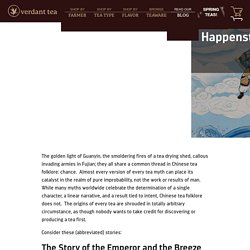
Almost every version of every tea myth can place its catalyst in the realm of pure improbability, not the work or results of man. While many myths worldwide celebrate the determination of a single character, a linear narrative, and a result tied to intent, Chinese tea folklore does not. The origins of every tea are shrouded in totally arbitrary circumstance, as though nobody wants to take credit for discovering or producing a tea first. Consider these (abbreviated) stories: The Story of the Emperor and the Breeze. Même sous Mao, la Chine n'a jamais cessé d'être Taoïste.
Il y a quelque temps, deux bus se sont télescopés dans la région de Canton. Introduction to Mao Zedong Thought. This is an Archived Course EdX keeps courses open for enrollment after they end to allow learners to explore content and continue learning. All features and materials may not be available, and course content will not be updated. Quotations from Chairman Mao Tse-tung. 1964 book of statements by Mao Zedong Quotations from Chairman Mao Tse-tung (simplified Chinese: 毛主席语录; traditional Chinese: 毛主席語錄; pinyin: Máo Zhǔxí Yǔlù) is a book of statements from speeches and writings by Mao Zedong (formerly romanized as Mao Tse-tung), the former Chairman of the Chinese Communist Party, published from 1964 to about 1976 and widely distributed during the Cultural Revolution.
The most popular versions were printed in small sizes that could be easily carried and were bound in bright red covers, thus commonly becoming known internationally as the Little Red Book. Publication process[edit] WISDOMCHINA. Collected and translated by Yuwu Song (Copyrights Reserved) ACCUMULATIONThree feet of ice is not frozen in one day. PROVERB. Wengu - Chinese Classics. Revue de presse / Press review Harrison Z. Les Classiques chinois. Les Classiques chinois.
Sun Tzu's Art of War. Sun Tzu - L'art de la guerre_.pdf. Thucydide, Sun Tzu et Guiguzi ou l’art de (conceptualiser) la guerre. Théoriser la guerre sans en rater sa réalité La guerre, tout le monde en a une idée, l’histoire et l’actualité nous y confrontent régulièrement. Danger + opportunity ≠ crisis. There is a widespread public misperception, particularly among the New Age sector, that the Chinese word for “crisis” is composed of elements that signify “danger” and “opportunity.” I first encountered this curious specimen of alleged oriental wisdom about ten years ago at an altitude of 35,000 feet sitting next to an American executive. He was intently studying a bound volume that had adopted this notorious formulation as the basic premise of its method for making increased profits even when the market is falling. At that moment, I didn't have the heart to disappoint my gullible neighbor who was blissfully imbibing what he assumed were the gems of Far Eastern sagacity enshrined within the pages of his workbook.
Now, however, the damage from this kind of pseudo-profundity has reached such gross proportions that I feel obliged, as a responsible Sinologist, to take counteraction. Mianzi e guanxi nella cultura cinese: due concetti fondamentali per capire la Cina. East Meets West: An Infographic Portrait. By Maria Popova What’s not to love about minimalist infographics — such an elegant way to depict complex concepts with brilliant simplicity.
We also have a longtime love affair with social psychology, some of which deals with the fascinating cultural differences between Eastern and Western mentality — from the individualistic tendencies of the West versus the pluralism of Asian societies, to how differently Westerners and Easterners read the emotions of others. The Useless Tree. La vie et la mort selon la pensée chinoise. De Mao à Confucius, des monuments au "rêve chinois" du président. The influential Confucian philosopher you’ve never heard of. A man is hiking in the countryside when he suddenly sees a toddler about to fall into an abandoned well.
What will he do? Many people will instinctively run toward the toddler to save him. Why Are Hundreds of Harvard Students Studying Ancient Chinese Philosophy? Picture a world where human relationships are challenging, narcissism and self-centeredness are on the rise, and there is disagreement on the best way for people to live harmoniously together. It sounds like 21st-century America. But the society that Michael Puett, a tall, 48-year-old bespectacled professor of Chinese history at Harvard University, is describing to more than 700 rapt undergraduates is China, 2,500 years ago. Puett's course Classical Chinese Ethical and Political Theory has become the third most popular course at the university. La storia dei cinesi negli Stati Uniti ci fa capire il razzismo di oggi - Igiaba Scego. -
Study of the I ching, Tao te ching. Yi. YI King & Qi Gong. Qigong Summary. Qi gong (Chi Kung) The Life Touch of Healing. Qi Gong. Qi gong. Qi Gong Also Known as Chi Chung. Qigong Practice: Pei Yuan Qigong. By Hu Xuezhi, Wang Tao, edited by Vietanh 1. Enrich Jing to foster the very original Choose any standing, sitting, lying posture. The sitting posture is preferable; for walking the novice is not easy to master the points. So, it is advisable not to try at beginning for novice. Once the practice begins, please follow the following sequence: Introduction to Taiji Five-Element Qigong. Internal Practices-Lotus Nei Gong.
Baduanjin qigong. Qi Energy - Feel the Qi (Chi) Energy Flow and Increase It. Walking_With_Qi.
Taichichuan. Learn tai chi. Tai Ji Quan. TCM Lifestyle. Chinese Formulas by Category - Comprehensive Reference of Chinese Herbal Medicines. Makko Ho meridian stretches. Chinese. Chinese New Year Calendar. Chinese Horoscope. The Essence of the Chinese Calendar. Chine et kung fu. Singing Dragon. ChinesePuzzles.org - Art and Ingenuity. Arts divinatoires chinois. Asia blog. Eastonline - Ultime News dal mondo - opinioni e approfodimenti dal mondo. ChinElectrodoc, blog de veille sur le monde chinois. China Files. Chine - China. La Chine et ses périphéries de l’Ouest (Tibet, Xinjiang) » Print. La Chine. Chinese Revolution. The Chinese Revolution of 1949 - 1945–1952.
Remembering the biggest mass murder in the history of the world. A Most Secret Tragedy. Culture chinoise. De Mao à Confucius, le "rêve chinois" A Chinese alternative? Interpreting the politics of China's `New Left' Un sogno cinese di mezza estate. Shanzhai. China’s Economy, by the Numbers, Is Worse Than It Looks.